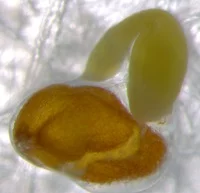based on a press release text of Johanne Uhrenholt Kusnitzoff, University of Kopenhagen
A milestone has been reached in the research of zinc loading in crop seeds with large potential benefits to people in the developing world. A team of scientists, led by Professor Michael Broberg Palmgren from the Department of Plant and Environmental Sciences at University of Copenhagen, has just published an article about their findings in Nature Plants, which might well lead the way to growing crops with more zinc accumulated in the seeds.
Michael Broberg Palmgren explains about the breakthrough: “We have identified the specific system of transport in the plant cells responsible for delivering zinc into the seeds. That knowledge unveils the path to breeding plants with enhanced activity of this particular transport system resulting in more zinc rich seeds.”
This until now seemingly unnoticed mechanism can improve the nutritional value of a large part of the human diet, since Biologists have yet to discover any type of crop that does not have a variant of these so-called zinc pumps, Michael Broberg Palmgren explains. Meaning, that if you can breed a variant of rye with enhanced zinc loading in the seeds, in all likelihood it will be possible to do the same with wheat, barley, rice and so on.
Postdoc and first author on the published article, Lene Irene Olsen, also from the Department of Plant and Environmental Sciences, describes the origin and progress of the study: “Basically, we started the project because we knew from other studies that zinc pumps play a significant role in zinc uptake in the roots of the small weed Arabidopsis or thale cress. That made us think that it might play a role in zinc loading of the plant seeds as well, and we then started out identifying if the pumps were even present in the seeds. They were. Then we had to determine the actual importance of the pumps in zinc loading of seeds. We did that by breeding mutant thale cress with no zinc pumps in the seeds and comparing the seed amount of zinc with thale cress with their zinc pumps intact. We found that the mutant plants had accumulated the zinc in the husks and none in the seed, proving that zinc pumps are the key factor in delivering the micronutrient from the plant to the seed.“
Microscopic chemical imaging by means of synchrotron-based micro-X-Ray Fluorescence (micro-XRF) as well as micro-particle-induced X-ray Emission (micro-PIXE) coupled to micro-Rutherford backscattering Spectroscopy (micro-RBS) played a key role in elucidating the importance of the zinc pumps. For the mutants with a ‘defect’ zinc pump system, chemical imaging provided clear evidence of a pronounced accumulation of zinc in the seed coat and a complete blockage of the cellular export of zinc towards to endosperm and embryo, the seed itself. Based on such high spatial resolution chemical images the zinc-impermeable mother plant/filial tissue component could be identified. Founded on this most fundamental information, the corresponding membrane transport processes could be studied in detail.
Link to the press release of University Copenhagen
Read the full story
Mother plant-mediated pumping of zinc into the developing seedL.I. Olsen, T.H. Hansen, C. Larue, J.T. Østerberg, R.D. Hoffmann, J. Liesche, U. Krämer, S. Surblé, S. Cadarsi, V.A. Samson, D. Grolimund, S. Husted, and M. Palmgren
Nature Plants, article number: 16036 (2016), published online: 11 April 2016
DOI: 10.1038/nplants.2016.36
Contact
Prof Dr Michael PalmgrenDepartment of Plant and Environmental Sciences
University of Copenhagen
DK-1871 Frederiksberg, Denmark
Dr Camille Larue
CNRS/ECOLAB
31326 Castanet Tolosan Cedex, FRANCE
Dr Daniel Grolimund
Laboratory for Synchrotron Radiation and Femtochemistry
Swiss Light Source, Paul Scherrer Intitute
5232 Villigen-PSI, Switzerland

